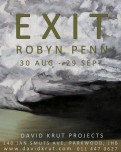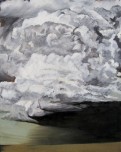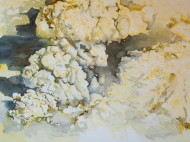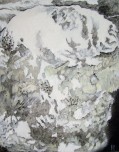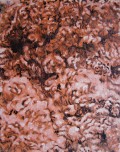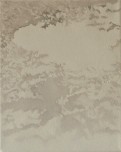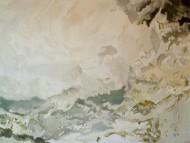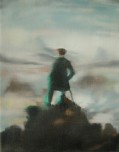Opening Thursday 30 August, 6.30pm at David Krut Projects, 142 Jan Smuts Avenue, Parkwood, Johannesburg.
Exit is Robyn Penn’s second solo exhibition at David Krut Projects, following Pretty World at Arts on Main in November 2011. In this new body of paintings Penn continues her exploration of the sublime through multiple images, but has made significant formal and conceptual departures.
Penn consistently uses photographs as references for series of works, creating new works from the same image as a way to “push the image, coming back to it again and again; re-seeing it, re-imagining it.” Both for Pretty World and for this new work, images of clouds taken by Eadward Muybridge have proved an appropriate starting point not only because his subject matter resonates with Penn, but also because his repetitive use of clouds is similar to her own. Working in the 19th century, Muybridge would photograph dramatic cloudscapes, which he would then add to his landscapes using a method of manual “Photo-shopping,” often re-using the same clouds in different images, in order to provide depth. For Penn, clouds present a metaphor for distraction from the chaos happening on the ground. They also satisfy an interest in the Romantic sublime, notably evident in the paintings of Caspar David Friedrich. Her thoughts on these overlapping refrains have led her to consider other images relating to powerful and potentially disastrous cloudscapes added directly or indirectly to the natural world by humankind. Following on from Pretty World, Penn has sourced images of mushroom clouds, shuttle launch clouds, volcanic ash and implosion clouds which, removed from their original contexts, appear as quite innocuous and very beautiful formations.
This body of work also features paintings of fire escape structures that have fascinated Penn for similar reasons – as inoffensive structures used exclusively for emergency escape. For Penn, the metaphorical connection between the two kinds of imagery relates to the “ambiguity, openness, and indeterminacy of sky [that] cause the here-and-now to dissolve to some extent. We exit to or from, escape to or from something. In both there is always an element of hope. We no longer live in Friedrich’s naively romantic world. We live in a world of crisis where shuttles escape Earth’s gravity, the threat of mushroom clouds looms large and solitary clouds drift across blue skies.”
The ambiguities of both clouds and fire escapes are important to Penn as she has focused her interest in the science of how we see. Specific areas within the visual cortex are responsible for seeing movement, shape and colour; information received by the eyes is broken up and synthesised into patterns and forms in a predictable way. Similarly, in reproducing images from photographic source material, Penn breaks the images up into tones, lines and shapes, according to the way that she sees them. In this body of work, rather than smooth away the evidence of this process, Penn has allowed the marks and traces of the under-painting to show through, thereby complicating the trompe l’oeil effect.
On a personal level, Penn’s daily practice in her home studio mirrors the repetitive nature of domesticity, but is also an escape from the mundane. Once her reference images are selected, working and re-working them becomes a meditation similar to the distraction of cloud gazing. In this body of work, her movement away from faithful figurative representation is also symbolic, in a sense, of an escape from realism.
Robyn Penn – ARTIST’S STATEMENT:
This body of work started, as all my work does, with the notion of the sublime and I began my investigation with small ink drawings and gouache paintings of clouds by Eadweard Muybridge, a photographer of the mid-19th century. Sky and clouds resonate for me, providing a necessary quiet from the chaos happening on the ground. Clouds are an easy metaphor for distractions and in this sense, Muybridge’s clouds are marvellous. He photographed dramatic clouds and then manually ‘Photo-shopped’[1] them into his landscapes to provide more depth. He often re-used the same clouds in several different landscapes. Referencing Muybridge led me to the idea of clouds ‘added’ to the landscape and the view that we very often add metaphorical clouds to our psychological landscapes. Of course, there have also been some extremely potent, very real clouds added by humans to natural landscapes. This is how I started looking at atomic bomb clouds and recently I have also been looking at shuttle launch clouds, volcanic ash and implosion clouds.
I always begin with a photo, either taking one or finding one. On their own they are often not much to look at, they are not necessarily good photos, but for me the hold they have is hidden somewhere else. They are ubiquitous windows onto some wonder beyond themselves.The use of the photo as source material is central to the way I work. I couldn’t make the same paintings if I were working from life. There is a power to glimpsing something ‘other’ in an image and being able to hold it in my hand and coax it out onto the surface of my canvas over days and weeks. Being able to push or pull an aspect of an image with oil painting’s slow grasp so that it reflects more accurately what I feel about it.
The whole idea of seeing interests me. Particularly relating to painting and to neuroscience. In studying damage to the human brain, neuroscience has been able to locate specific areas within the visual cortex responsible for de-coding/seeing movement, colour, and so on. How we see relies heavily on the physical structure of our brains. What is seen with the eyes is broken up and synthesised into particular patterns and forms in a predictable way. In making this new body of work I have focused on how I see the image and break it up into tones, lines and shapes. The finished work retains traces of these marks and of the under painting rather than being smoothed away from view. I have sought to develop a level of perceptual ambivalence, to move away from realism and towards abstraction. Our everyday experience of the world is frequently informed by and mediated by images. Very often all we know of a situation is through media, television and news. All I know of the Iceland volcano or atomic bombs is through images –two-dimensional representations of a three-dimensional concept
While living in an apartment I photographed fire escapes on neighbouring buildings. At the time it wasn’t clear to me why, but they interested me as innocuous structures meant exclusively for escape. Emergency exit. There is an escapist aspect to my cloud gazing. For a long time I have been captivated by the boundlessness of the sky and that place where the sky meets the land and transcends the immediate, the personal, and represents something universal.This ambiguity, openness, and indeterminacy of sky, for me, cause the here-and-now to slip away, dissolve to some extent. We exit to or from, escape to or from something. In both there is always an element of hope. We no longer live in Caspar Friedrich’s naively romantic world. We live in a world of crisis where shuttles escape Earth’s gravity, the threat of mushroom clouds loom large and solitary clouds drift across blue skies.
As always I am deeply engaged in working with multiples. I make new paintings using the same reference; they are the same image once more, like an instant replaying itself. Working in series makes sense to me. I am able to push the image, coming back to it again and again; re-seeing it, re-imagining it. Working in my home studio daily my practice also mirrors the repetitive nature of domesticity. It is also what keeps me sane. It is an escape from the mundane. I make decisions up front, selecting reference images, then working and re-working them becomes a meditation.In this body of work, my movement away from faithful figurative representation is symbolic, in a sense, of an escape from realism.
What all my work has in common is the influence of Romantic painter Caspar Friedrich, artist Vija Celmins, writer/poet Charles Bukowski, a preoccupation with the sublime and the sky, multiple images, my interest in neuroscience and my relationship with the world.
For me the reality of life is like a Charles Bukowski poem – brutal and beautiful in the same breath.
[1]Muybridge did this by masking one print before adding on the cloud print. This early “Photo-shopping” was widely accepted at the time and was seen as a creative process, as opposed to a trick or a cheat as is often the opinion of “Photo-shopped” images today.
The images below are an archive of the exhibition. For available work, please click here.

